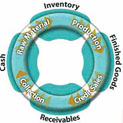Issue No.11 / July 16,2015

In the previous issue we were discussing how to read a Balance Sheet
You will recall, I had said, if you wish to read a Balance Sheet, make sure it has not more than four items on the Liabilities’ side and not more than two on the Assets’ as shown here.
Let’s try and reduce the number of items on the Liabilities’ side also to two.
How do we do that?Let’s look for similarities between items on the Liabilities’ side which can be clubbed together.
There are various possibilities.
Should we combine the first two items (Share Capital and Reserves) and the last two items (Long-Term Loans and Current Liabilities)?
A better way would be to club the first three items. All of these, Share Capital, Reserves & Surplus, as well as Long-Term Loans, represent long-term funds (LTF) or long-term sources (LTS)
| Balance Sheet | |
|---|---|
| Liabilities | Assets |
| Share Capital | Fixed Assets |
| Reserves & Surplus | |
| Long-Term Loans | Current Assets |
| Current Liabilities | |
Share Capital is for the longest term. It does not have to be repaid in the lifetime of the company.
Reserves are often as long term as share capital. Even though reserves can be used to distribute as dividends in the years when the company makes losses, this provision is rarely used. If reserves are used at all, it is often to distribute bonus shares – that is, shares which are issued free of cost – amongst the existing shareholders. When this is done, the amount gets transferred from the head reserves to the head share capital.
Finally, the Long-Term Loans are obviously long term in nature We can safely say that current liabilities are short-term sources (STS), since an item is classified as a current liability only if it has to be repaid within one year from the date of the Balance Sheet.
Similarly, on the Assets’ side, we would not be wrong in saying that Fixed Assets represent long term uses of funds (LTU), being made up of items such as land and building and machinery and equipment, all of which are purchased for use over the long term.
The current assets, which represent gross working capital, can likewise be called a short term use of money (STU). In fact the movement of items of current assets (comprising cash, inventory and debtors) can be depicted in the form of a cycle as shown here.
| Balance Sheet | |
|---|---|
| Liabilities | Assets |
| Share Capital | Fixed Assets LTU |
| Reserves & Surplus LTS | |
| Long-Term Loans | Current Assets STU |
| Current Liabilities STS | |

The inventory then goes through a manufacturing process and gets converted to a finished product.
When a sale is made, the finished-goods inventory becomes debtors or receivables.
On the due date, when collection is made from debtors, it gets converted to cash again. This cycle of cash-to-cash is called the working-capital cycle.
Profitable organizations know that the key to success is to have a shorter working-capital cycle. Every attempt must be made to shorten this cycle.
...to be continued
By Dr Anil lAmBA